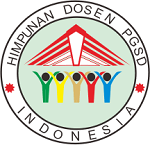MENINGKATKAN MOTIVASI BELAJAR SISWA PADA MATA PELAJARAN SEJARAH POKOK BAHASAN KERAJAAN MALAKA DENGAN MENGGUNAKAN METODE BRAINSTORMING DI KELAS X IS-3 SMA NEGERI 1 STM HILIR TAHUN PELAJARAN 2019/2020
DOI:
https://doi.org/10.24114/jgk.v5i3.26842Abstract
Abstract: Increasing Students' Learning Motivation in the Main History Subjects of the Kingdom of Malacca Using the Brainstorming Method in Class X Is-3 Sma Negeri 1 Stm Downstream for the 2019/2020 Academic Year. This study aims to determine the increase in students' learning motivation using the Brainstorming method in Class X IS-3 SMA Negeri 1 STM Hilir for the 2019/2020 academic year. The research method is in the form of classroom action and the research subject is Class X. The class consists of 30 students. Based on the learning outcomes of the first cycle, the average score was 72. After the second cycle, there was an increase to 86.93. In this study, the data obtained for individual and classical learning completeness criteria were as many as 30 students or 100%. Thus the learning in this study can be said to be complete. The level of student mastery of the material being taught, which is made based on the final test is 100% of students who have very high mastery. Based on the results of the research above, it can be seen that learning using the Brainstorming method can increase student learning motivation in Class IS-3 SMA Negeri 1 STM Hilir for the 2019/2020 academic year. Keyword: Learning motivation, Brainstorming Method. Abstrak: Meningkatkan Motivasi Belajar Siswa Pada Mata Pelajaran Sejarah Pokok Bahasan Kerajaan Malaka Dengan Menggunakan Metode Brainstorming Di Kelas X Is-3 Sma Negeri 1 Stm Hilir Tahun Pelajaran 2019/2020. Penelitian ini bertujuan untuk mengetahui peningkatan motivasi belajar siswa dengan menggunakan metode Brainstorming di Kelas X IS-3 SMA Negeri 1 STM Hilir Tahun Pelajaran 2019/2020. Metode penelitian berupa penelitian tindakan kelas dan subjek penelitian adalah Kelas X. Kelas yang diteliti terdiri dari 30 orang siswa. Berdasarkan hasil belajar dari siklus I, diperoleh nilai rata-rata 72. Setelah suklus II, terjadi peningkatan menjadi 86,93. Pada penelitian ini diperoleh data kriteria ketuntasan belajar individu dan klasikal, menjadi sebanyak 30 siswa atau sebesar 100%. Dengan demikian pembelajaran pada penelitian ini dapat dikatakan telah tuntas.Tingkat penguasaan siswa terhadap materi yang diajarkan, yang dibuat berdasarkan tes akhir adalah 100% siswa yang mempunyai penguasaan sangat tinggi. Berdasarkan hasil penelitian di atas, dapat disimpulkan bahwa pembelajaran dengan menggunakan metode Brainstorming dapat meningkatkan motivasi belajar siswa di Kelas IS-3 SMA Negeri 1 STM Hilir Tahun Pelajaran 2019/2020. Kata Kunci: Motivasi belajar, Metode Brainstorming.References
Affandy. 2008.http//affandy.ss.blog.plasa.com/2008/06/28/Brainstorming/ (Accessed Juni 2009)
Ayan, Jordan. 2002. Bengkel Kreativitas. Bandung : Kaifa
Arikunto, Suharsimi dkk. 2010. Penelitian Tindakan Kelas. Jakarta: Bumi Aksara
Dewi, Rosmala. 2010. Penelitian Tindakan Kelas.Medan : cv darma
Djamarah. 2006. Strategi Belajar Mengajar. Jakarta : Rineka Cipta
Eveline. 2010. Teori dan Pembelajaran.Bogor : Ghalia Indonesia
Hamdani. 2010. Strategi Belajar Mengajar. Bandung : Pustaka Setia
_______. 2011. Strategi Belajar Mengajar. Bandung : Pustaka Setia
Iskandar. 2009. Psikologi Pendidikan. Cipayung : Guang Persada
Nurani, Yuliani. 2003. Strategi Pembelajran. Jakarta : Universitas Terbuka
Rinella Putri (Dalam http//vibinews.com/journal.php?id=88&page=hr
Roestiyah. 2008. Strategi Belajar Mengajar. Jakarta : Rineka Cipta
Sagala, S. 2009. Konsep dan Makna Pembelajaran.Bandung : Alfabeta
Downloads
Published
How to Cite
Issue
Section
License
Authors published with the JGK (Jurnal Guru Kita) agree to the following terms:
- Authors retain copyright and grant the journal the right of first publication with the work simultaneously licensed under a Creative Commons Attribution License (CC BY-SA 4.0) that allows others to share the work with an acknowledgment of the work's authorship and initial publication in this journal.
- Authors are able to enter into separate, additional contractual arrangements for the non-exclusive distribution of the journal's published version of the work (e.g., post it to an institutional repository or publish it in a book), with an acknowledgment of its initial publication in this journal.
- Authors are permitted and encouraged to post their work online (e.g., in institutional repositories or on their website) prior to and during the submission process, as it can lead to productive exchanges, as well as earlier and greater citation of published work. (See The Effect of Open Access)


























